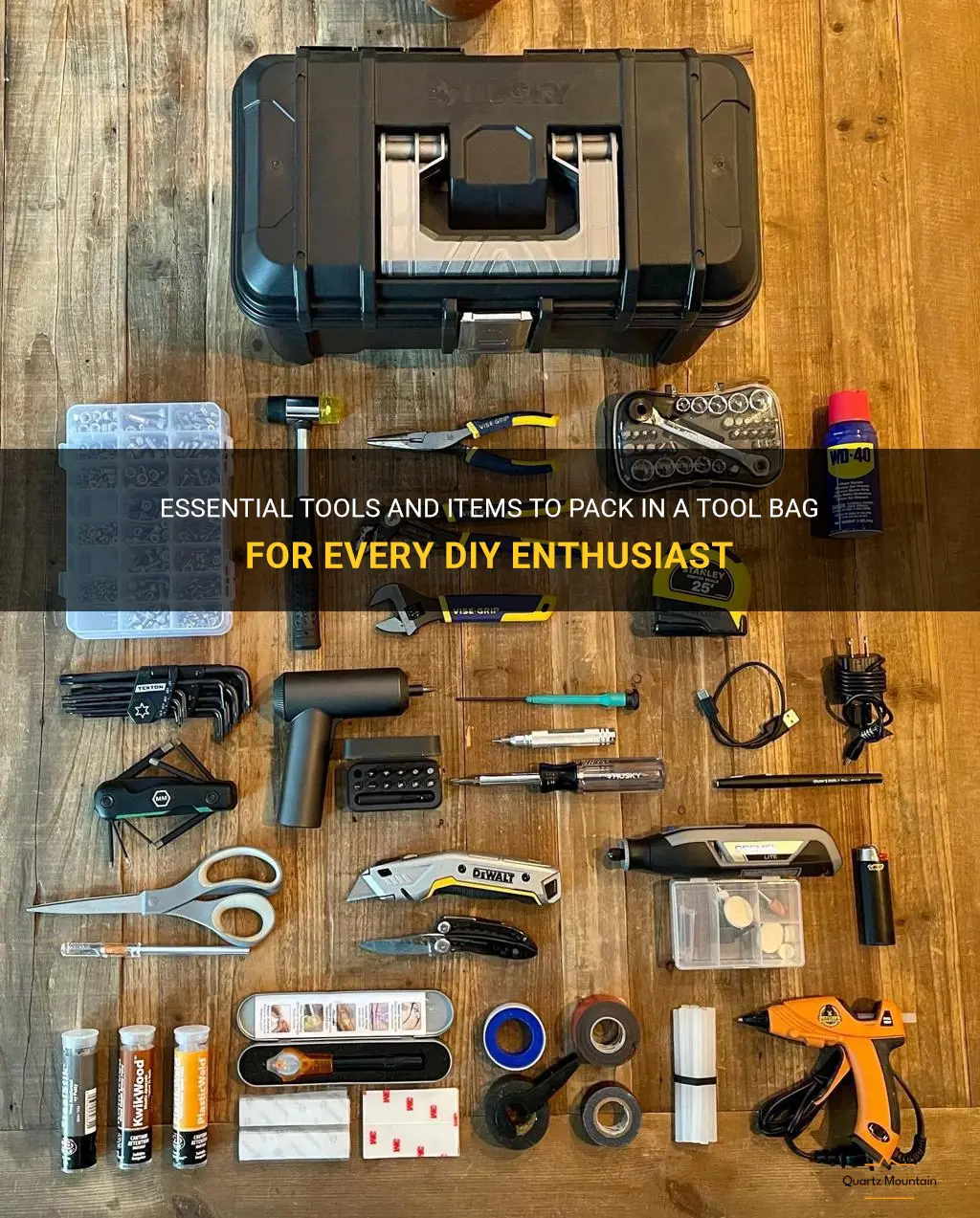
Are you a DIY enthusiast who loves working on projects around your home or workshop? Whether you're a seasoned pro or just getting started, having the right tools and items in your tool bag is essential. From hammers and screwdrivers to levels and tape measures, the possibilities are endless when it comes to the tools you may need. In this guide, we will explore the essential tools and items that every DIY enthusiast should have in their tool bag. So, grab your tool bag and let's get started on building the ultimate DIY toolkit!
What You'll Learn
- What are the essential tools that should be included in a basic tool bag?
- Are there any specific tools or equipment that should be included for electrical work in a tool bag?
- How should tools be organized in a tool bag to maximize efficiency and accessibility?
- Are there any additional safety items or equipment that should be packed in a tool bag?
- What are some tips for maintaining and keeping a tool bag in good condition?

What are the essential tools that should be included in a basic tool bag?
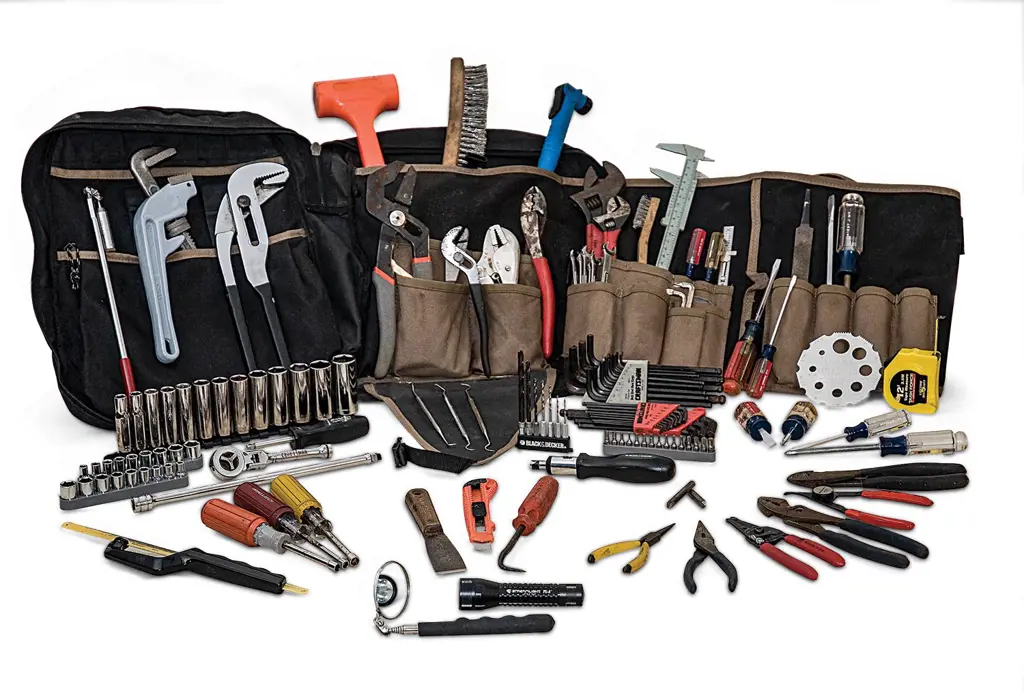
Having a basic tool bag is essential for any homeowner or DIY enthusiast. With the right tools, you can tackle various projects around the house, from simple repairs to more complex renovations. However, it can be overwhelming to know which tools are necessary for a basic tool bag. In this article, we will outline the essential tools that should be included in a basic tool bag, along with their uses and why they are important.
- Hammer: A hammer is a versatile tool that comes in handy for a wide range of tasks. Whether you need to hang a picture frame or drive nails into wood, a hammer is a must-have tool in any basic tool bag. Look for a hammer with a comfortable grip and a head that is both sturdy and lightweight.
- Screwdrivers: Another important tool for any basic tool bag is a set of screwdrivers. Different types of screwdrivers, such as flathead and Phillips head, will be required for various projects. A screwdriver with a magnetic tip can be especially useful, as it makes it easier to handle small screws.
- Pliers: Pliers are used for gripping and manipulating objects with precision. They are particularly helpful when dealing with wires, removing nails, or loosening tight bolts. Look for pliers that are made of high-quality steel, as they will be more durable and less likely to bend under pressure.
- Tape Measure: Accurate measurements are crucial for any project, whether you are hanging curtains or building a bookshelf. A tape measure is an essential tool for ensuring precise measurements. Look for a tape measure that has both metric and imperial measurements and a locking feature to keep the tape in place.
- Utility Knife: A utility knife is a versatile tool that can be used for a variety of tasks, such as cutting boxes, carpet, or wallpaper. Look for a utility knife with a retractable blade for safety and ease of use. Make sure to keep extra blades on hand, as they can dull quickly.
- Level: A level is necessary for ensuring that objects are straight and even. Whether you are hanging shelves or pictures, a level will ensure that everything is properly aligned. Look for a level that is made of durable materials and has both horizontal and vertical vials.
- Adjustable Wrench: An adjustable wrench is a handy tool for tightening or loosening nuts and bolts of various sizes. Look for a wrench with a comfortable grip and a wide jaw opening to accommodate different sizes. A quality adjustable wrench can save you time and frustration when dealing with plumbing or mechanical repairs.
- Safety Glasses: Safety should always be a priority when working with tools. Safety glasses provide essential eye protection and should be worn whenever there is a risk of flying debris. Look for safety glasses that are ANSI-approved and have impact-resistant lenses.
- Allen Wrench Set: An Allen wrench set, also known as a hex key set, is necessary for assembling furniture, tightening screws on bicycles, or adjusting electronic equipment. Look for a set that includes various sizes and a carrying case for easy storage.
- Toolbox: Lastly, having a reliable and sturdy toolbox to store your tools is essential. Look for a toolbox that has a good amount of storage space, compartments for organizing different tools, and a comfortable handle for easy transportation.
In conclusion, a basic tool bag should include a hammer, screwdrivers, pliers, tape measure, utility knife, level, adjustable wrench, safety glasses, Allen wrench set, and a toolbox. These tools will cover a wide range of tasks and are essential for any homeowner or DIY enthusiast. Investing in high-quality tools will not only save you time and money but also ensure that your projects are completed safely and efficiently.
Essential Items to Pack for a City Break to Berlin
You may want to see also

Are there any specific tools or equipment that should be included for electrical work in a tool bag?
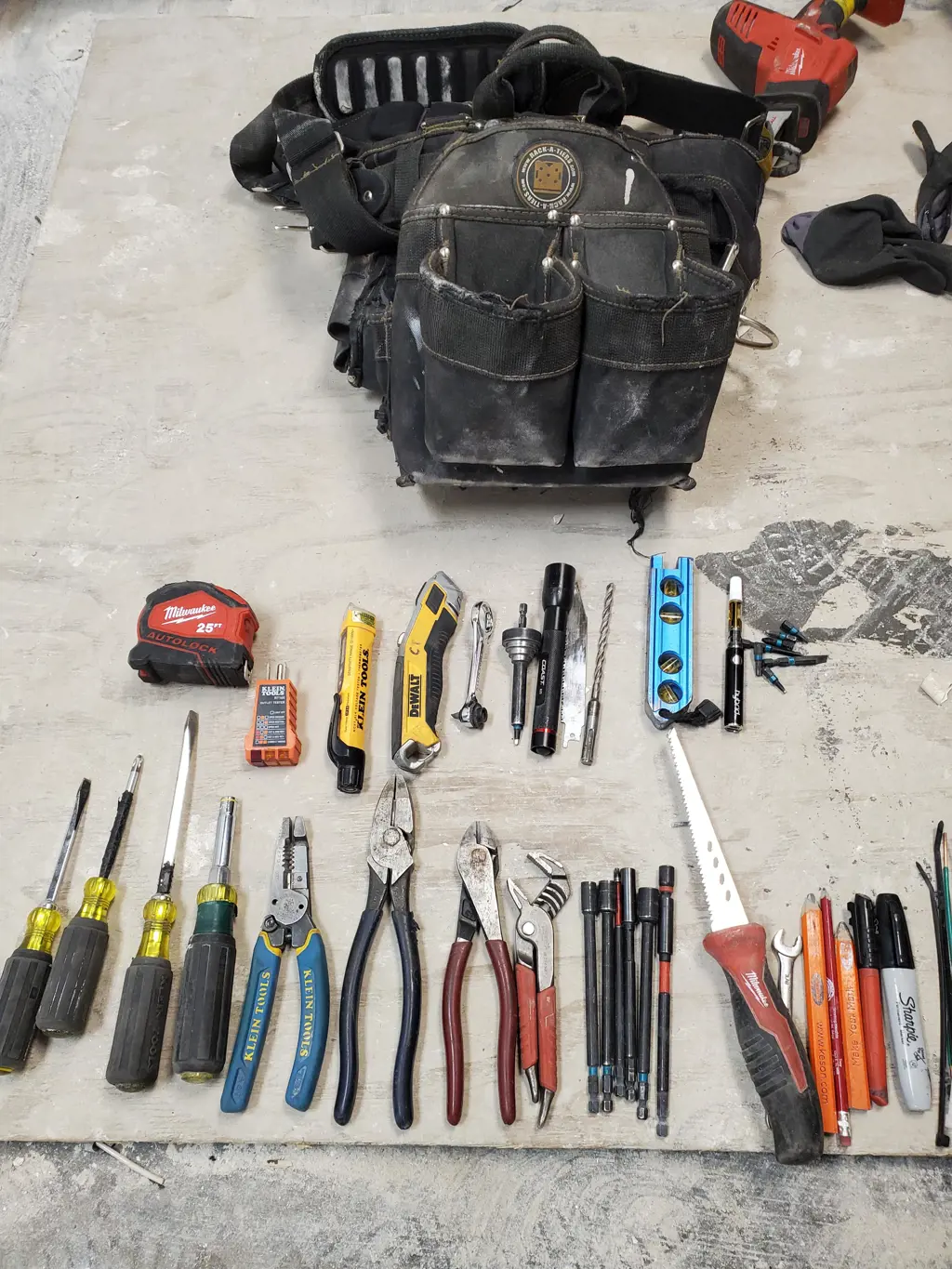
When it comes to electrical work, having a well-stocked tool bag is essential. The right tools not only make the job easier but also ensure that the work is done safely and efficiently. There are a few specific tools and equipment that should be included in every electrician's tool bag. Let's take a closer look at some of them.
- Screwdrivers: A good set of screwdrivers is a must-have for any electrician. You will need both flathead and Phillips head screwdrivers in various sizes to fit different types of screws. Look for screwdrivers with insulated handles to protect against electrical shock.
- Wire Strippers: Wire strippers are used to remove the insulation from electrical wires. They have sharp blades that cut through the insulation without damaging the wire. It's important to have wire strippers that are suitable for the gauge of wire you will be working with.
- Pliers: Pliers are versatile tools that can be used for various tasks in electrical work. Needle-nose pliers are especially useful for bending and twisting wires, while lineman's pliers are ideal for cutting and stripping wires. Look for pliers with insulated handles for added safety.
- Voltage Tester: A voltage tester is essential for determining whether a circuit is live or not. It is a handheld device that can detect the presence of electricity in a wire or outlet. Always use a voltage tester before working on any electrical circuit to ensure your safety.
- Wire Nuts: Wire nuts, also known as twist-on wire connectors, are used to connect or join two or more electrical wires. They come in different sizes to accommodate different wire gauges. Wire nuts should be included in your tool bag for making reliable and secure connections.
- Electrical Tape: Electrical tape is a type of insulating tape that is used to protect and insulate electrical connections. It is often used to wrap wires and prevent them from touching each other or other conductive surfaces. Make sure to have a roll or two of electrical tape in your tool bag.
- Circuit Tester: A circuit tester is a handy tool for troubleshooting electrical circuits. It can be used to check if a circuit is properly grounded or if there is a break in the wiring. A circuit tester typically has a series of lights or an audible indicator to indicate the status of the circuit.
- Flashlight: A good flashlight is essential when working in dark or poorly lit areas. It can help you see what you're doing and avoid potential hazards. Look for a flashlight with a bright and long-lasting LED bulb.
- Insulated Gloves: Insulated gloves are an important safety accessory for electrical work. They provide protection against electrical shock and should be worn whenever working with live wires or electrical equipment. Make sure to choose gloves that are rated for the voltage you will be working with.
- Tool Pouch or Belt: A tool pouch or belt is a convenient way to keep your tools organized and easily accessible. It allows you to have your most frequently used tools within reach at all times, saving you time and effort.
In addition to these tools, it's also important to have a good quality tool bag or toolbox to store and transport your tools safely. Keep in mind that electrical work can be dangerous, so it's crucial to always prioritize safety and follow proper procedures when working with electricity.
Essential Items to Pack for a Fun-Filled Camp Ozark Experience
You may want to see also

How should tools be organized in a tool bag to maximize efficiency and accessibility?
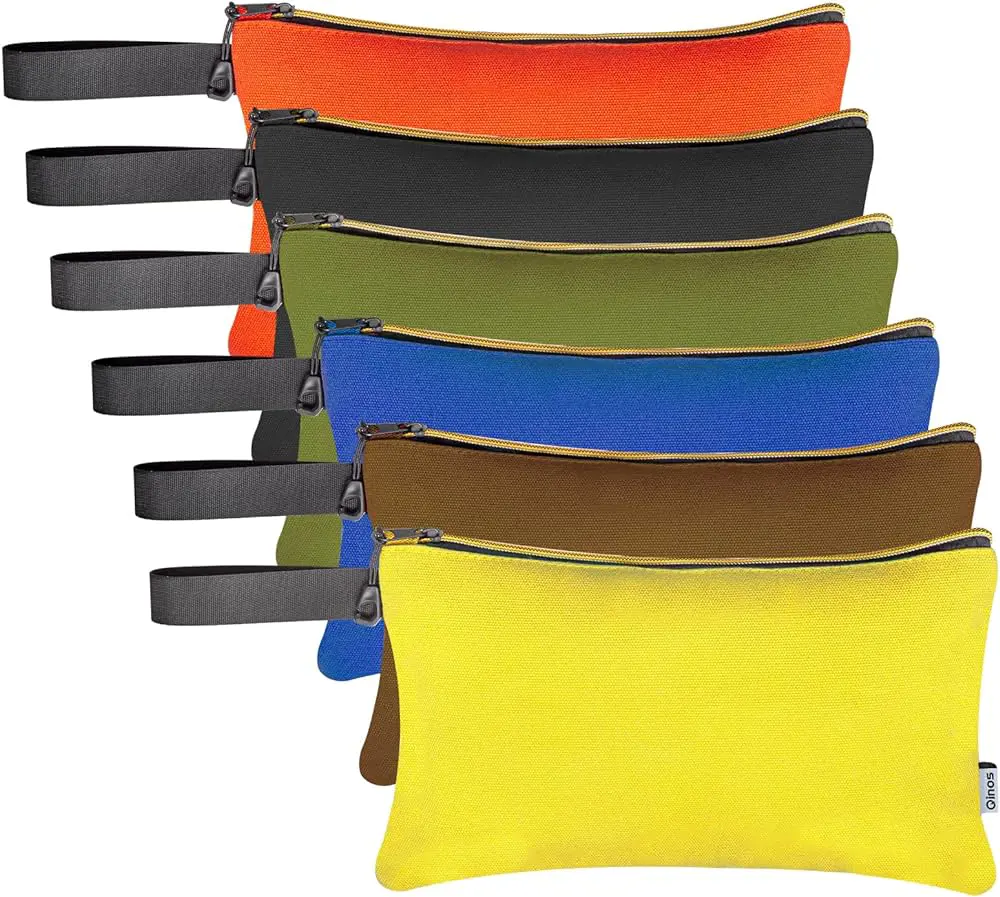
When it comes to organizing tools in a tool bag, efficiency and accessibility are key factors to consider. Having a well-organized tool bag can save you time and frustration, especially in high-pressure situations where you need to quickly locate the right tool. There are several approaches you can take to maximize efficiency and accessibility in your tool bag organization.
- Categorize the tools: Start by categorizing your tools into different groups based on their function or type. For example, you can have separate sections for wrenches, screwdrivers, pliers, electrical tools, and so on. This helps you quickly locate the tools you need without wasting time rummaging through an unorganized bag.
- Use tool pouches or compartments: Invest in a tool bag that has built-in pouches or compartments. These allow you to keep your tools separate and organized, making it easier to find what you need. Place similar tools together in the same pouch or compartment to further enhance accessibility.
- Arrange tools by frequency of use: Another approach is to organize your tools based on how frequently you use them. Keep the frequently used tools in a readily accessible section of your bag, such as in the front pockets or top compartments. Less frequently used tools can be placed in the deeper or less accessible sections of the bag.
- Utilize tool rolls or sleeves: Tool rolls or sleeves are a great way to keep your tools organized and protected. They allow you to roll up your tools and secure them with Velcro or snap closures. This not only keeps the tools organized but also prevents them from rattling around and potentially getting damaged.
- Label or color-code your tools: Consider labeling or color-coding your tools to enhance accessibility. This can be especially helpful when working in low-light conditions or when you need to quickly identify a specific tool. Use labels or colored tape to indicate the function or size of the tool.
- Keep small items secure: Small items like screws, nuts, and bolts can easily get lost in a tool bag. Use small containers or pouches to keep these items secure and prevent them from mixing with your tools. Transparent containers or pouches are particularly useful as they allow you to see the contents without having to open them.
- Regularly declutter and reorganize: Over time, your tool bag may become cluttered with items you rarely use or tools that have been damaged. Make it a habit to regularly declutter your tool bag and remove any unnecessary items. This will not only keep your bag organized but also help lighten your load.
In conclusion, organizing tools in a tool bag can greatly enhance efficiency and accessibility. Categorizing tools, using pouches or compartments, arranging tools by frequency of use, and utilizing tool rolls or sleeves are all effective strategies. Labeling or color-coding tools, keeping small items secure, and regularly decluttering the tool bag are additional steps you can take to maximize efficiency and accessibility. By implementing these organizational techniques, you'll be able to quickly locate and retrieve the right tool for any job, ultimately saving time and frustration.
The Complete Packing Guide for a Trip to Dallas
You may want to see also

Are there any additional safety items or equipment that should be packed in a tool bag?
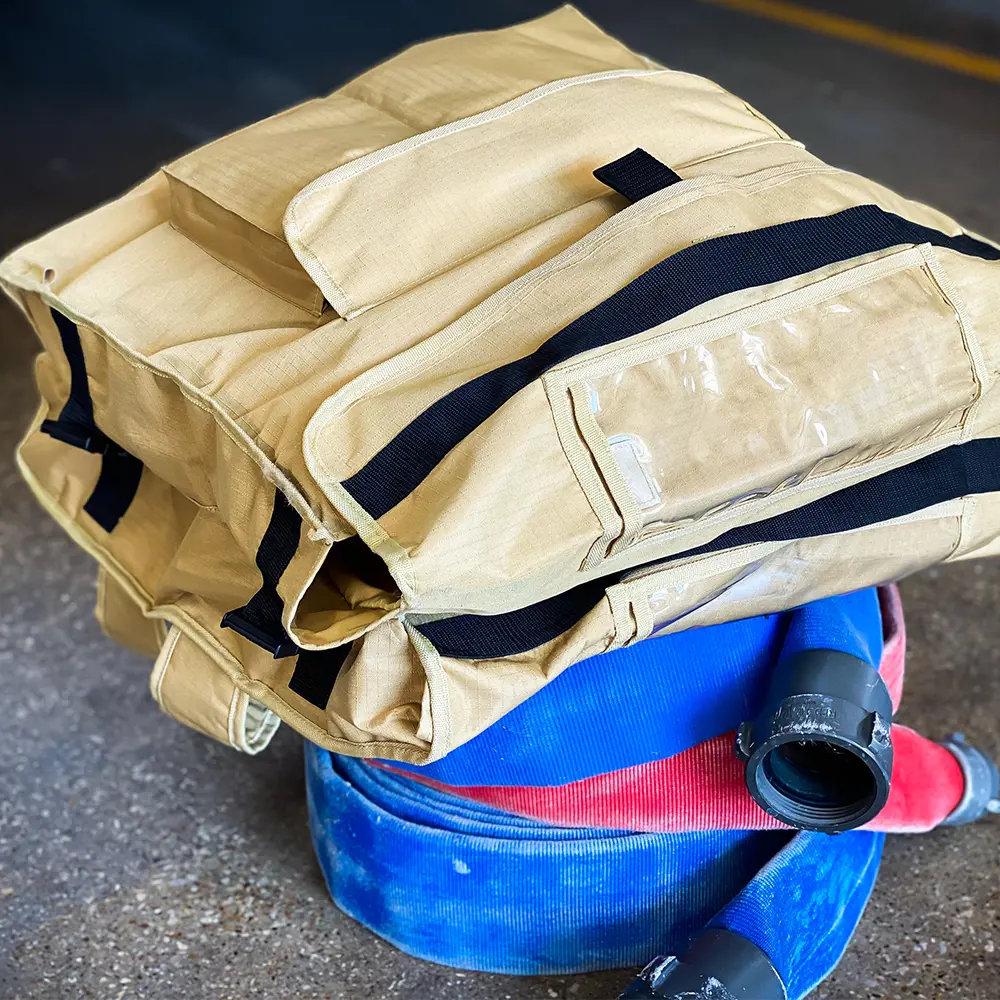
When working with tools, it is essential to prioritize safety. In addition to the usual tools that are carried in a tool bag, there are some additional safety items and equipment that should also be packed. These extra items can help prevent accidents and protect both the user and those around them.
One important safety item to include in a tool bag is a pair of safety glasses or goggles. These help protect the eyes from debris, dust, and other hazards that could cause injury. When using power tools or working in environments where there is a risk of flying particles, safety glasses are particularly important. It is always better to err on the side of caution and wear them, even if the task seems relatively low risk.
Another helpful addition to a tool bag is a set of work gloves. These protect the hands from cuts, abrasions, and burns. When handling sharp objects or working with chemicals, gloves provide an extra layer of protection. It is important to choose gloves that are appropriate for the specific task at hand. Some gloves offer additional features like heat resistance or extra grip, which can be useful in certain situations.
A first aid kit is also an essential safety item to have in a tool bag. Accidents can happen, and having basic first aid supplies readily available can make a significant difference in the outcome. The first aid kit should include items such as adhesive bandages, sterile gauze, antiseptic wipes, and gloves. It is also a good idea to include any necessary personal medications, such as an EpiPen for allergies or asthma inhalers.
A fire extinguisher is an often overlooked but critical safety item to have in a tool bag. Fires can start unexpectedly, particularly when working with power tools or in environments with flammable materials. Having a small, compact fire extinguisher handy can help contain a fire before it spreads, potentially saving lives and property. It is important to regularly check the expiration date on the fire extinguisher and ensure it is in good working condition.
Lastly, a tool bag should include personal protective equipment specific to the task at hand. For example, if working with chemicals, it is important to have appropriate gloves, goggles, and a respirator if needed. If working at heights, a harness and lanyard are essential for fall protection. It is crucial to assess the specific risks associated with each task and include the necessary safety equipment in the tool bag.
In conclusion, when packing a tool bag, it is important to prioritize safety. Additional safety items and equipment, such as safety glasses, work gloves, a first aid kit, a fire extinguisher, and task-specific personal protective equipment, can help prevent accidents and protect the user and those around them. By being prepared and equipped with the right safety gear, individuals can ensure a safer working environment.
Essential Items for Hiking in the Dolomites: Your Complete Packing Guide
You may want to see also

What are some tips for maintaining and keeping a tool bag in good condition?
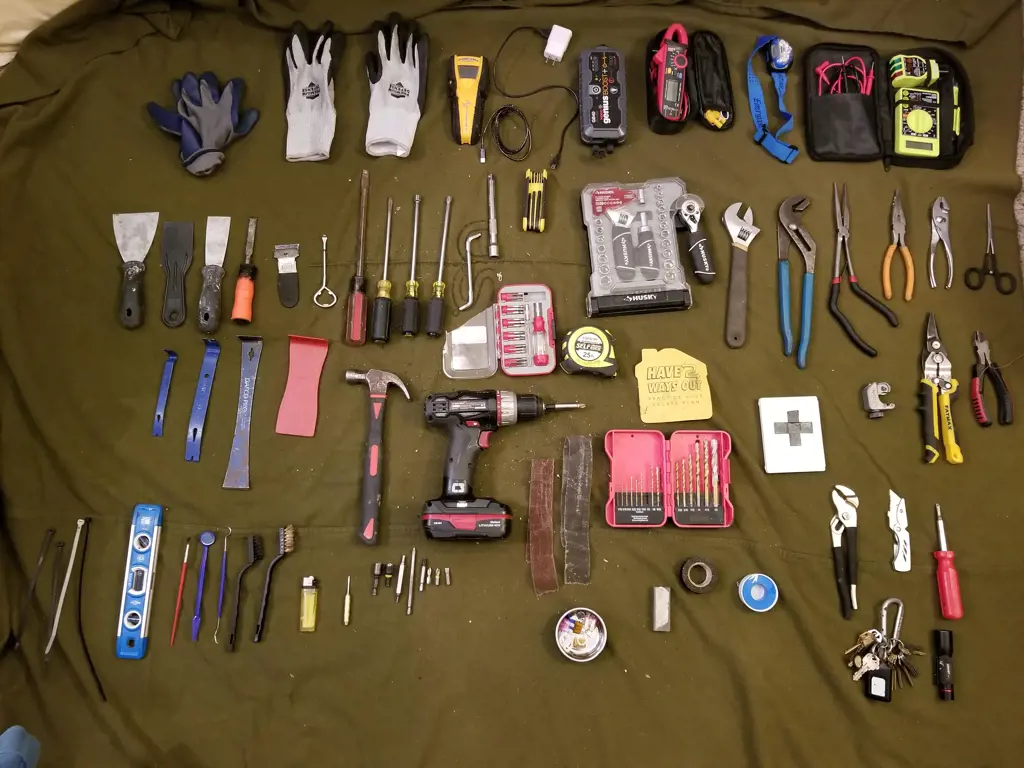
A tool bag is an essential item for anyone who regularly uses tools. It allows you to keep all your tools organized and easily accessible, whether you are working in your garage or on a job site. To ensure that your tool bag functions properly and lasts for a long time, it is important to take proper care of it. Here are some tips for maintaining and keeping a tool bag in good condition.
- Keep it Clean: Regularly clean your tool bag to remove dirt, dust, and debris. Use a damp cloth or a soft brush to wipe down the exterior and interior of the bag. Avoid using harsh chemicals or abrasive cleaners, as they can damage the fabric or material of the bag.
- Empty it Out: After each use, empty your tool bag and remove any tools or items that you no longer need. This will help prevent unnecessary wear and tear on the bag and ensure that it is not overloaded with excess weight.
- Organize Tools: Take the time to organize your tools in the bag. Use dividers or pockets to keep similar tools together. This will make it easier to find and retrieve the tool you need when you are working on a project.
- Protect Sharp Objects: If you have sharp tools or objects in your bag, such as knives or scissors, make sure to protect them and prevent them from damaging the bag. Consider using blade guards or sheaths to cover the sharp edges and prevent them from poking through the bag.
- Avoid Overloading: Be mindful of the weight capacity of your tool bag and avoid overloading it. Overloading can cause the bag to become overstretched, leading to tears or damage to the seams. If you need to carry a large number of tools, consider using a larger or more durable bag.
- Repair Tears or Damages: If you notice any tears or damages in your tool bag, it is important to repair them promptly. Use a strong adhesive or fabric repair tape to fix small tears. For larger damages, consider taking the bag to a professional who can provide proper repairs.
- Store Properly: When you are not using your tool bag, store it in a clean and dry place. Avoid exposing it to extreme temperatures, moisture, or direct sunlight, as these can cause the bag to deteriorate more quickly.
- Regular Inspections: Periodically inspect your tool bag for any signs of wear and tear. Check the zippers, seams, handles, and straps for any damage. If any parts are showing signs of wear or beginning to fail, consider replacing or repairing them.
By following these tips, you can ensure that your tool bag remains in good condition and continues to serve you well for years to come. Proper maintenance and care will not only extend the lifespan of your tool bag but also help you stay organized and efficient in your work. Remember to invest in a high-quality tool bag that is designed to withstand the demands of your work, as this will make a significant difference in its durability and longevity.
The Ultimate Guide to Packing for a Beach Getaway in Malibu
You may want to see also
Frequently asked questions
The essential tools to pack in a tool bag include a hammer, screwdrivers (both flathead and Phillips), pliers, adjustable wrench, tape measure, utility knife, and a set of various sized screws and nails. These tools will cover a wide range of basic home repair and maintenance tasks.
Packing power tools in your tool bag is not necessary, as they can be bulky and heavy. However, if you anticipate needing power tools for a specific task, such as drilling holes or cutting materials, it may be worth considering packing a cordless drill and/or a portable jigsaw. Otherwise, it is generally more practical to keep power tools separate and easily accessible in a designated area.
While it is not necessary to pack heavy-duty safety equipment in your tool bag, it is important to have some basic safety gear on hand. This can include safety glasses, ear plugs, work gloves, and a dust mask. These items will help protect you from common hazards and ensure that you are prepared for any unexpected situations that may arise.
The choice to include specialized tools in your tool bag will depend on the specific tasks you anticipate needing to complete. For example, if you frequently work with electrical wiring, it may be beneficial to pack wire strippers and a voltage tester. If you often work with plumbing, consider including pipe wrenches and a pipe cutter. Evaluate your regular DIY projects and adjust your tool bag accordingly.
Yes, it is important to regularly check and update the contents of your tool bag. Over time, tools may become damaged or worn out, so it is important to replace them as needed. Additionally, as you gain experience and take on new projects, you may find that you need different tools or accessories. Taking inventory of your tool bag periodically will ensure that you have everything you need for your current projects and avoid any frustrating last-minute trips to the hardware store.







